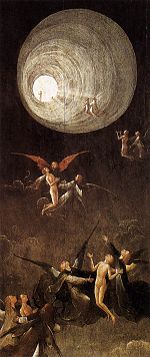Near-death experience
|
|
Near-death experience, also known as NDE, is the common name for feelings, impressions and out-of-body experiences reported by people who have been resuscitated.[1]
Such reports date back to the time of Plato who wrote about the Myth of Er.[2], but the term near-death experience was coined by a psychologist, Raymond Moody, in his bestselling book, Life after Life, first published in 1975.[3] The book was a compilation of the experiences reported by more than 100 people who came close to death. Moody believes in an afterlife, and regards these reports as possible supporting evidence for this, while recognising that there are other explanations. Generally however, scientists consider that NDEs arise from the disordered activity of a brain under extreme stress that is interpreted in a way conditioned by expectations.
In a later book, Moody wrote: “By the classical definition, death is the state from which you don't return. It is defined as irreversible. Hence, since all of the NDEers returned, they were never really dead. What happened was that various criteria for death were fufilled" [4] [5] Both adults and children report similar NDE experiences.[6] Similar experiences have been reported by others, including when someone is participating in meditation, under emotional duress or at the bedside of a dying loved one. [7]
Did the NDE experiencer really die?
Moody, in The Light Beyond, writes: "The lesson of all this is that there is a lot we don't know about the physiology of dying. So technically speaking, NDEers are never really dead, but they are much closer than most of us have ever been." [4] He explains that, by the classical definition, death is the state from which you don't return. Death being irreversible, the people who survived and returned to report their NDE were never really dead.
Scales
Two primary scales are used to score NDE experiences. In 1980, psychologist Kenneth Ring developed a 10 point interview scale, which he used to interview 102 people who had come close to death. The interview using the scale determined
- ↑ Blackmore SJ (1996) Near-death experiences J R Soc Med 89:73-6. Review. PMID 8683504
- ↑ Myth of Er (Plato, Republic X). Retrieved on 2011-01-11.
- ↑ Raymond Moody (2001) Life After Life: the investigation of a phenomenon – survival of bodily death, San Francisco, CA: Harper SanFrancisco ISBN 0-06251739-2
- ↑ 4.0 4.1 Perry, Paul; Moody, Raymond A (1988). The Light Beyond. New York: Bantam Books. ISBN 0-553-05285-3.
- ↑ Eelco FM et al. (2010) Evidence-based guideline update: Determining brain death in adults: Report of the Quality Standards Subcommittee of the American Academy of Neurology Neurology 74:1911>
- ↑ Morse M et al. (1985) Near-death experiences in a pediatric population Am J Dis Child139:595-600 PMID 4003364
- ↑ www.iands.org. Retrieved on 2011-01-11.
